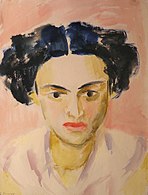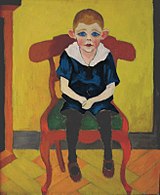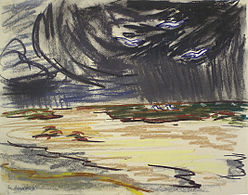Erwin Hinrichs
The painter Erwin Hinrichs (born August 20, 1904 in Schleswig ; † April 13, 1962 in Rendsburg ) is considered one of the last representatives of Schleswig-Holstein's late expressionism . In addition to Niko Wöhlk (1887–1950) and Leonore Vespermann (1900–1974), he is one of the most important painters of this style, which was to be observed as "the fascinating re-bloom of Expressionism in Schleswig-Holstein".
Youth and education
Erwin Hinrichs was the first of four children of the Sparkasse director Volquard Hinrichs and his wife Emma Hinrichs geb. Carstens. He spent his childhood and youth in Schleswig until he was 15, then in Rendsburg. As a teenager, he received his first artistic inspiration from Niko Wöhlk and Hans Holtorf , the older friends from the "Schleswiger Wandervogel ". After graduating from high school, Hinrichs went to Munich in 1924 and studied nude , drawing , portrait , still life painting and figurative composition at the Hans Hofmann painting school in the winter months . During the summer months he painted on the North Sea coast or he trained with Hans Holtorf on the Flensburg Fjord . In 1927 he spent a long time in Italy, mainly in Forio on Ischia . In 1929 he temporarily returned to Rendsburg.
As a freelance artist from 1929 until the end of the war

From 1932 Hinrichs' works were exhibited regularly and received mostly positive reviews. Around this time he joined forces with the painter Leonore Vespermann and the painter Hans Rickers , both from Kiel, to form the watercolor group of the Werkgemeinschaft Kieler Künstler. In 1938 Erich Duggen was added. The Kieler Werkgemeinschaft existed until the outbreak of war. The artists often worked together, especially on the North Sea on the Eiderstedt peninsula . The work results were shown at joint exhibitions in Liegnitz, Kiel, Hamburg and Wilhelmshaven. After 1933 Hinrichs and the other painters of the Kieler Werkgemeinschaft were initially little affected and Hinrichs was still able to show his work in solo exhibitions in Braunschweig, Hamburg and Berlin. This changed from around 1937; a solo exhibition in Berlin at the von der Heyde gallery had to be taken down shortly before the opening in 1937 due to " degeneracy ". This was repeated in 1939: some of the planned works were not allowed due to "degeneracy". During the entire war period from 1939 to 1945, Hinrichs was an anti-aircraft soldier and had almost no opportunity for artistic activity.
Shortly before the outbreak of war, Hinrichs met Karl Schmidt-Rottluff . This resulted in an exchange of letters and an exchange of some watercolor works that lasted into the post-war period. The correspondence and two watercolors given by Schmidt-Rottluff to Erwin Hinrichs were taken over by the Schleswig-Holstein State Museum after Hinrichs' death.
post war period
After his return from English captivity, Hinrichs worked again as a freelance artist. Like other artists of the “ missing generation ” he remained unsuccessful and finally took a job as an art teacher at the Rendsburg Waldorf School , especially since he was now a family man and had four children. With his wife Anna Marie, geb. Rosenstein (1910–1991), he had been married since 1939. In 1962, he died at the age of almost 58 years at a pneumonia . After his early death, Erwin Hinrichs was initially forgotten. It was only in the late 1970s that it was possible to draw the public's attention to the painter, who was born in Schleswig, and to make a number of new, previously overlooked aspects of his oeuvre visible. A major retrospective of his work was shown in 1980 in the Schleswig City Museum.
About the artist's work
Hinrichs is widely known as a painter of landscape watercolors. His strongly colored leaves, painted wet on wet , are characterized by a balanced composition and an intense expression of the atmospheric. It is precisely the aesthetics of damp, hazy and wet that characterize the landscape of Schleswig-Holstein to a great extent, which is sure to find expression in Hinrichs' watercolors. Many of his landscapes are of an emphatic serenity. But the painter Hinrichs was anything but cheerful. Rather, he suffered from his vocation as a visual artist. This is clearly shown next to his red chalk sketches and self-portraits in the woodcut “The Look Back” from 1946, which shows a ghost seer who is deeply frightened by his own vision and whose facial expression seems to reflect the experience of the war that has just passed. Hinrichs' tendency to melancholy was evident in everyday life when he did not want to succeed in artistic expression or was denied for external reasons, because in his time as an art teacher he only came to painting during holidays. But then he went to the North Sea regularly. Most of his later watercolors were created on the island of Pellworm . Dunes, mud flats, water and cloud formations were his preferred motif, which he painted in an enormous variety of color nuances and shapes, from delicate gray in gray as the only color in the picture to dike landscapes in rich green tones to evening moods in bright orange. The “Old Church” on Pellworm from the 13th century also often served as a motif. He also made woodcuts and linocuts such as the pieces “Alter Friese”, “Mädchen im Wind”, “Sealfischer”, “Norne” and the self-portrait above. The red chalk drawings mentioned come from an earlier creative period before the war ("The reaper", "Bootssteg", "Elfriede mit Hut", "Reclining girl" etc.). He also carved the “girl in the wind” (approx. 30 cm high) as a sculpture in wood, as well as “Susanna in the bath” and the group of three of the “dying soldier”. Hinrichs' oil paintings are numerically less represented in the complete works, but no less characteristic of his painting style. Mention should be made here of “My Brother Günther”, various “Still Life with Flowers”, “The Prisoners of War”, “Orphaned Horses”, “Old Haubarg” and others.
Exhibitions
Exhibitions and participation in exhibitions in Munich, Hamburg, Berlin, Kiel, Liegnitz, Lübeck, Wilhelmshaven, Flensburg, Bremen, Münster, Speyer, Bielefeld, Braunschweig, Rendsburg and Schleswig.
estate
Parts of his estate are kept in the Schleswig-Holstein State Museum in Gottorf Castle. The rest of the estate is in the possession of family members as well as private individuals and various institutions:
- Schleswig-Holstein State Museum
- City of Schleswig
- City of Rendsburg
- Kunsthalle Kiel
- Museum Witten / Ruhr
- Hotel Waldschlösschen, Schleswig
- Waldorf schools in Germany
- Private individuals in Berlin, Hamburg, New York etc.
literature
- Wilhelm Wessling: Erwin Hinrichs. Painting against the times. An artist's life in Schleswig-Holstein against the background of political and art-historical upheavals in the 20th century. Husum Verlag, Husum 1996, ISBN 3-88042-790-9
- Christian Rathke: Comments on the artistic work of Erwin Hinrichs. In: Otto von Wahl and Wolfgang Laur (eds.): Contributions to the history of the city of Schleswig. Volume 25, 1980, pp. 160-171.
- Wilhelm Wessling: Memories of the painter Erwin Hinrichs. In: Jahrbuch der Heimatgemeinde Eckernförde eV Volume 39, 1981, pp. 105–117.
- Wilhelm Wessling: The painter Erwin Hinrichs and his Eiderstedter years. In: Between Eider and Wiedau. Home calendar North Friesland. Year 1982, pp. 176–179, ISSN 0514-8413
- Wilhelm Wessling: Hinrichs, Erwin. In: Biographical Lexicon for Schleswig-Holstein and Lübeck. Volume 9, Wachholtz, Neumünster 1991, ISBN 3-529-02649-2 , pp. 152-154
Web links
- Literature by and about Erwin Hinrichs in the catalog of the German National Library
Individual evidence
- ^ Christian Rathke in the exhibition catalog: Erwin Hinrichs, oil paintings, watercolors, graphics. Retrospective at the Städtisches Museum Schleswig from May 9 to June 15, 1980
- ^ Complete list of exhibitions from Wilhelm Wessling: Erwin Hinrichs. Painting against the times. Page 110
| personal data | |
|---|---|
| SURNAME | Hinrichs, Erwin |
| BRIEF DESCRIPTION | German painter |
| DATE OF BIRTH | 20th August 1904 |
| PLACE OF BIRTH | Schleswig |
| DATE OF DEATH | April 13, 1962 |
| Place of death | Rendsburg |










